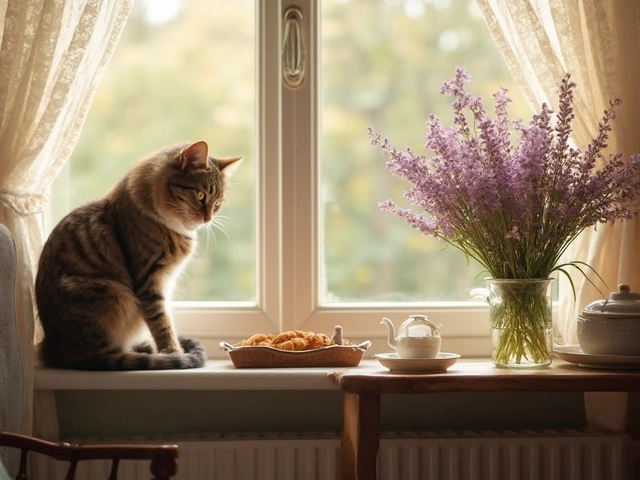Picture your dog watching you head off to bed, that hopeful look on their face. Should they follow you under the covers, curl up in a cushy bed nearby, or trot over to a crate? It’s a nightly decision that shapes your dog’s comfort, security, and your own sleep. Some swear their dog gets the sweetest sleep snuggling under the blankets, while others say crates are a must for safety and routine. But what’s truly best for your best friend?
How Dogs Naturally Sleep: Instincts, Comfort, and Modern Homes
Wild dogs never picked out memory foam. They needed security from predators, warmth, and a safe place to rest their heads. Fast forward to the modern home, and most pet dogs still seem to chase those same instincts—just somewhere far cozier (and safer) than their ancestors had. Here’s the twist: dogs are “den animals,” meaning they feel calm in snug, protected spots. That’s why you’ll sometimes catch your pup squishing themselves into a corner, under a table, or beside the sofa, even if a premium dog bed is right there.
This den instinct is why crates can work so well, especially for puppies or anxious dogs. The American Veterinary Medical Association points out that a crate isn’t a prison, but more like your dog’s bedroom. Given the chance, many dogs will actually seek out their own tight little retreat come bedtime—even if given the run of the house—especially if the crate is introduced in a gentle way.
A lot of breeds are prone to burrowing. Think dachshunds, terriers, and even larger breeds like huskies. Offering bedding they can nest in or little corners to hide helps them feel settled at night. But then there’s the argument for human beds: studies such as one published by the Mayo Clinic found that over 50% of pet owners let dogs sleep in bed with them. Short-term, both owner and dog often feel more secure and emotionally connected. On the other hand, research also shows dogs can disturb human sleep—tossing, turning, hogging the covers, or just breathing too loudly (as anyone with a snoring bulldog can tell you).
Here’s a fun fact: dogs, unlike cats, tend to sleep at night with their people, syncing their cycles to ours. Healthy adult dogs snooze for about 12–14 hours spread throughout the day and night, but bedtime with you is the main event. Puppy owners should know, though, that young dogs nap more and wake more at night—meaning where a dog sleeps can affect housetraining and sleep quality for everyone in the house.
The past is all about dens and safety, but today it comes down to real habits: Dogs want access to you for comfort, yet crave their private sanctuary for true deep rest. Getting it right just takes figuring out what suits your pup (and your lifestyle) best.
Exploring the Options: Beds, Crates, and Co-Sleeping Choices
Let’s break it down to the most popular choices: dog beds, human beds, and crates. Each has its super fans. Each comes with practical perks—and a few things to watch out for.
Dog beds are a classic for a reason. These days, there are orthopedic beds for seniors, waterproof pads for messy pups, and heated models for cold nights. The Humane Society recommends beds for nearly every dog, especially as they age or if joint support is needed. An orthopedic dog bed can reduce arthritis pain and stiffness, while a plush, donut-shaped style can make small breeds feel extra safe. Dogs with allergies? Choose washable covers and hypoallergenic fillers. Many dog parents place beds in a quiet corner of the bedroom or living room, letting their dog "check in" but also escape from household chaos. The trick is to make it inviting: think soft blankets, a favorite toy, and the familiar scents of family.
Crates are another tried-and-true sleeping spot, especially for training new puppies or adopted dogs unfamiliar with home routines. Crate training helps with housebreaking and lessens risk—chewing cords or getting into trash at night is a thing of the past. The American Kennel Club suggests that a crate the right size (just big enough for turning and stretching) sets many dogs up for sleep success. You can toss in a soft mat and a chew-proof toy. Don’t forget: dogs aren’t meant to stay in a crate for hours on end. They love company, so only use crates for sleeping or short absences.
Now, the most debated pick: your own bed. Snuggling with your dog can boost oxytocin, lower stress, and make cold nights a little less lonely. Roughly half of all dog owners admit their dog claims a spot under the covers or on top of their feet. But is it good sleep for either of you? According to a 2022 sleep study published in "Sleep Health," about 20% of dog owners reported waking up during the night because of their dog. Large breeds are more likely to hog space, while small breeds might just steal your pillow. There’s also a risk for allergies or cleanliness issues (be honest—dogs bring in dirt, pollen, and the odd pest).
Not all dogs are naturals at co-sleeping. Some are restless or anxious, while others—especially older or arthritic pups—struggle to climb up and down. That’s why you’ll see some dog parents opting for a cozy dog bed right next to theirs, or even a plush crate in the same room so their pup is close but not on top of their face.
- Dog beds made of memory foam are excellent for seniors with stiff joints.
- Crates are best for puppies, anxious dogs, or households with lots of hazards.
- Co-sleeping can help with anxiety in both dog and human but may lead to disrupted sleep or cleanliness concerns.
Whichever option you pick, the goal is the same: restful nights for both you and your four-legged buddy.

The Human Side: Sleep, Safety, and Strengthening Bonds
Here’s the thing—where your dog sleeps isn’t just about them. It’s about your health, safety, and the daily bond you share. Sharing your bed might lead to more cuddles, but it can also mean waking up to dog nails in your back or that special aroma of "wet dog fur." According to a 2021 survey by the American Pet Products Association, 43% of dog owners co-sleep with their pets, tuning in to the comfort and companionship it brings. For some, this comes at a cost: allergies flaring up, insomnia, or even a late-night trip to the vet because a dog leaped off the bed and landed wrong.
Here’s a real-life secret: sleep experts at the Mayo Clinic found that letting your dog sleep in your bedroom, but not necessarily on your bed, balanced the emotional perks and improved sleep quality. Most people felt safe and soothed with their pup nearby, but woke less often when the dog had its own space. For families with kids, having a dog sleep in the same room can also create a sense of calm, especially for nervous sleepers.
Let’s not forget practical safety: a crate or gated area can protect a chewing puppy from household hazards, like wires and cleaning supplies, that could be deadly. Dogs with health issues—epilepsy, arthritis, or severe anxiety—benefit from sleeping arrangements tailored to their needs. Some dogs need ramps, cooling pads, or extra warmth for old bones. For new adoptees or shelter pups, a consistent, safe sleeping spot reassures them as they transition into your family.
And then there’s the messy stuff. Dogs shed, bring in dirt, and sometimes have "accidents," especially if older or not fully house-trained. A proper dog bed (with a waterproof liner) or crate limits the chaos, means less laundry for you, and keeps everybody happier in the long run.
But isn’t sleep supposed to be about unwinding? Dogs thrive on routine—as any trainer will tell you. A nightly ritual of brushing, soft words, and tucking your dog into their favorite spot pays off in calmer nights. A strapline here: consistency + comfort = sweet dreams (for all paws and people involved).
On the flip side, don’t ignore your own boundaries. If snuggling with your dog is disrupting your sleep or causing you allergies, you’re not a "bad pet parent" for choosing a different setup. Consider baby gates, extra-cozy beds, or crates in your room, so you both get the peace you deserve.
| Option | Best for | Drawbacks |
|---|---|---|
| Dog Bed (in your room) | Seniors, mult-dog homes, allergy sufferers | Dogs may seek extra closeness |
| Crate | Puppies, nervous dogs, training periods | May dislike enclosure if not introduced gently |
| Human Bed | Calm, healthy dogs; owners craving closeness | Disrupts sleep, more mess, allergies |
Whether you’re a deep sleeper or a light one, find the balance that ensures everyone wakes up refreshed—and happy to see each other.
Making the Best Choice: Tips and Advice Tailored to Every Dog
Choosing the best place for your dog to sleep isn’t just a one-size-fits-all answer. It comes down to your dog’s age, health, personality, and even what kind of sleeper you are. Some pups will curl up happily anywhere. Others, especially rescue dogs or nervy breeds, need more structure—or more connection at night. The key is to pay close attention to what helps your dog truly relax.
- dog sleeping on your bed? Wash your sheets often, use a lint roller, and consider a waterproof mattress cover. It may sound like extra work, but it makes snuggles worry-free and keeps your bed fresh for all.
- Puppies thrive on crate training at night. Place the crate beside your bed for reassurance. Toss in a t-shirt you’ve worn, and offer a safe chew, so your puppy’s less likely to whine.
- Older dogs or big breeds with achy joints may prefer orthopedic foam beds. Set these in quiet, draft-free spots, close to where the family sleeps. Ramps or low beds make getting up and down easy.
- If allergies or light sleep keep you from co-sleeping, put your dog’s bed in the same room, and use positive reinforcement to help them settle in their own space.
- Travel a lot? Train your dog to sleep in a crate or portable bed, so new environments never leave them feeling lost at night.
Watch for clues your dog isn’t happy with their current spot: restlessness, whining, sneaking onto your bed, or scratching at the door. Sometimes just moving their bed, adding an extra blanket, or letting them sleep closer can fix everything. When bringing a new dog home, start with a cozy crate or bed in your room for extra security. As they settle, you might experiment with different locations to find what sticks.
Here’s a tip straight from experienced trainers: Don’t feed your dog right before bed, and keep nighttime outings calm and short. Avoid rough play at midnight—it signals “wake up!” not “wind down.” Instead, dim the lights and create a gentle bedtime routine, so your pup associates their sleeping spot with relaxation. If you’re crate training, cover the top with a light blanket for extra coziness, but always ensure airflow.
If you’re still unsure, experiment. Try a week with your dog in their bed beside yours, then see how co-sleeping works out. Notice which setup gives your dog more restful sleep and leaves you feeling ready for the day. Every dog is unique—what matters is finding harmony in your home, so both of you get the shut-eye you deserve.
No matter what you choose, your dog only wants to feel safe, loved, and part of your world. When you nail that, sleep will come easy for everyone (minus the snoring and nocturnal squirrel-chasing in dreams, of course).





